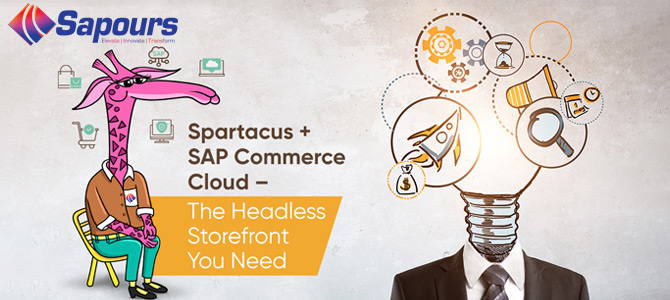In August 2022, Salesforce announced the release of the Composable Storefront, a headless storefront that enables retailers to quickly make changes to their online store. Thanks to its flexible architecture, retail and other industries are gradually transitioning towards headless commerce.
According to the Salesforce “State of Commerce” report, over 75% of commerce-based organizations have improved their business agility after adopting the headless architecture. An additional 80% plan to adopt this technology over the next two years.
Formerly known as SAP Hybris Commerce Cloud, SAP Commerce Cloud is the omnichannel commerce solution developed by SAP. As per a recent announcement, SAP Commerce is set to deprecate the following functionalities in its 2205 release:
- Accelerator UIs
- OCC template extensions (v1 and v2)
Through this deprecation, SAP Commerce Cloud aims to provide a headless commerce architecture with easier backend upgrades. How does this announcement impact businesses, and what is the available alternative? Let’s discuss this in detail.
How Does This Deprecation Impact Business Enterprises?
Post the deprecation, SAP will continue to support Accelerator UIs and OCC template extensions along with their add-ons. At the same time, SAP plans to develop an innovative headless-based storefront for future use. This deprecation allows SAP to focus on developing new OCC extensions that support more integrations with SAP Commerce.
Hence, this SAP Commerce deprecation should not impact any existing business operations or custom code. However, enterprises can plan the following activities post-deprecation:
- Upgrade all storefronts to support the new OCC functionalities.
- Transition to headless commerce using progressive web applications (PWAs).
- Plan for the gradual removal of the deprecated functionalities from SAP Commerce. SAP plans to remove Accelerator UIs from SAP Commerce in 2024 (Q2).
- Mitigate any potential issues with future SAP Commerce upgrades.
Next, let’s discuss why SAP is deprecating these features.
Why Is SAP Deprecating These Features?
The Accelerator UI function in SAP Commerce has not had any major updates from SAP. This functionality is tightly integrated into SAP Commerce, which makes it difficult to update or upgrade. Additionally, for future SAP Commerce releases, SAP users are not assured of backward compatibility with the Accelerator UI feature.
On the other hand, a decoupled (or headless) storefront adds more agility and flexibility to front-end implementation. It also enables storefronts to leverage new backend features. SAP’s decision to deprecate the Accelerator UIs and OCC extension is consistent with their decision to move towards a headless commerce architecture like that enabled by Spartacus.
What Is Spartacus?
Developed using AngularJS on SAP Commerce Cloud, Spartacus is a headless storefront and open-source library that separates SAP Commerce Cloud from the front end. Here are some of the key features of SAP Spartacus:
- An open-source headless storefront based on JavaScript
- A customizable storefront extendible at build and runtime
- Support for single-page applications with PWA capabilities
Here are some of the business benefits of adopting the SAP Spartacus framework:
- Enables merging new SAP Commerce releases into the storefront
- Supports the creation of multiple storefronts to deploy independently to the SAP Commerce platform
- Enables web crawlers to index content without any impact on the user experience
Is Spartacus the New Face of SAP Commerce Cloud?
As the JavaScript storefront for SAP Commerce Cloud, SAP Spartacus is all set to replace the legacy accelerator-based architecture. First, let’s look at the technology stack used in Spartacus:
- Angular 10 with TypeScript – Angular 10 is the component-driven framework where every component uses its encapsulated logic and style. TypeScript provides the type safety necessary to avoid runtime errors.
- NgRx – This technology provides Angular apps with reactive state management – and prevents inconsistencies and application bugs.
- Sass
- Jasmine with Karma
- Cypress for E2E testing
Here is why Spartacus is the new face of SAP Commerce Cloud:
- 100% API-driven – minimizes the interaction between front-end and backend components
- Eliminates the need for full-stack development
- Continuous delivery and release ensure that SAP customers can improve and deploy regularly
- Single-page applications (SPAs) provide a rich user experience with dynamic builds
- Designed with the capabilities and benefits of PWAs
- Support for server-side rendering designed for social media sharing and SEO practices
- 100% JavaScript-based storefront developed using Angular
- Seamless upgrades with new features into the custom storefront
Additionally, developers can easily create a customized Spartacus storefront (with SAP Commerce Cloud installed and running). SAP Spartacus uses REST API calls to communicate with SAP Commerce Cloud. Besides, it is configured to work with Omni-Channel Connect (or OCC). Developers can configure OCC adapters and endpoints to create lightweight Spartacus storefronts.
Conclusion
For the benefit of their customers, SAP will continue to support both Accelerator UIs and OCC extensions in the future. However, SAP customers should consider migrating to headless alternatives like SAP Spartacus. With its modern JavaScript framework, Spartacus provides a headless architecture that can positively impact developers’ experience and their productivity.
As an SAP technology partner, Sapours offers specialized services in the SAP Commerce Cloud. Here is how we can help you migrate your accelerator-based storefront to the Spartacus headless platform.
Get in touch with us and understand the benefits of the Spartacus storefront.

